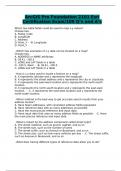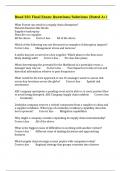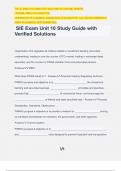ILTS 207 Exam 2024 | ILTS 207 Exam
Update Latest 2024 Questions and
Correct Answers Rated A+
Semantic web -ANSWER-Visual representation of the relationships
among words related to the text's subjects. This in turn enhances
student's understanding of the word's nuances of meaning.
Domain specific vocabulary -ANSWER-Language or word choice that
is directly related to the class for which you are writing. For example, if
you are writing a literary analysis essay for English, words like
"theme," "symbolism," and "juxtaposition" would be great examples. In
science, however, those words would not be as relevant- instead, you
might use words like "scientific method" and "molecular."
Infer -ANSWER-Using observation and background to reach a logical
conclusion. You probably practice this every day. For example, if you
see someone eating a new food and he or she makes a face, then you
____ he does not like it
Motivation in reading -ANSWER-Directly related to student's desire to
read for the purpose of either entertainment or education. A key factor
in connecting students to fiction is the presence of characters that are
relevant to student's personal experience.
Book study -ANSWER-An in depth talk about a book conducted by a
teacher. Similar to a book talk.
Conversational turn-taking -ANSWER-A a type of organization in
conversation and discourse where participants speak one at a time in
alternating turns. In practice, it involves processes for constructing
,contributions, responding to previous comments, and transitioning to a
different speaker, using a variety of linguistic and non-linguistic cues.
Phonemes -ANSWER-sounds of language
Morphemes -ANSWER-words and meaningful parts of words
Semantics -ANSWER-Meaning in language.
Syntax -ANSWER-Sentence structure in language.
Pragmatics -ANSWER-How language works in a social context
DR-TA -ANSWER-A teacher led model in which students are guided
in asking questions and making predictions about a text.
Contextual analysis -ANSWER-An analysis of a text (in whatever
medium, including multi-media) that helps us to assess that text as it
connects to its historical and cultural setting, but also in terms of its
textuality - or the qualities that characterize the text as a text.
Idiomatic expressions -ANSWER-An expression in the usage of a
language that is peculiar to itself either grammatically (such as no, it
wasn't me) or in having a meaning that cannot be derived from the
conjoined meanings of its elements (such as ride herd on for
"supervise")
Three Part Model -ANSWER-1 Qualitative Measures
The qualitative measures of text complexity requires an informed
judgment on the difficulty of the text by considering a range of factors.
The Standards use purpose or levels of meaning, structure, language
,conventionality and clarity, as well as the knowledge demands as
measures of text difficulty.
Rubrics have been developed for both literacy and informational texts
that include descriptors for:
• Layout
• Purpose and meaning
• Text structure
• Language features
• Knowledge demands
2 Quantitative Measures
Quantitative measures of text complexity use factors such as
sentence and word length and the frequency of unfamiliar words to
calculate the difficulty of the text, assigning a single measure (grade
level equivalent, number, Lexile etc). There are many formulas to
calculate text difficulty and, while they provide a guide, the readability
or difficulty level of a text can vary depending on which formulas or
measures are used.
Grade band equivalents
Lexile levels
3 Reader and Task
The third measure looks at what the student brings to the text and the
tasks that are assigned. Teachers need to use their knowledge of their
students and texts to match texts to particular students and tasks.
Inflections -ANSWER-The modification of a word to express different
grammatical categories such as tense, case, voice, aspect, person,
number, gender, and mood.
Derivations -ANSWER-The process of forming a new word from an
existing word, often by adding a prefix or suffix, such as -ness or un-.
For example, happiness and unhappy come from the root word happy.
, Compound words -ANSWER-Made up of two or more smaller words
that are combined to make a new word with its own meaning. The
smaller words that form this type of word are like puzzle pieces you fit
together to create a new bigger picture. Take the words milk and
shake. If we fit these pieces together, we get the ______ word
milkshake.
Morphology -ANSWER-The arrangement and relationships of the
smallest meaningful units in a language. So what does this really
mean? Every human language depends on sounds. When specific
sounds are put together in a specific way, words, phrases, and finally
sentences can be created. This is how messages are sent and
received.
Morphemes -ANSWER-The smallest unit of a word with meaning.
That meaning is how language conveys messages. _______ are more
than just letters. When a number of letters are put together into a word
part that now has meaning, then you have a/an ______.
Think-pair-share -ANSWER-A collaborative learning strategy in which
students work together to solve a problem or answer a question about
an assigned reading. This technique requires students to (1)
individually contemplate a topic or answer to a question, and (2)
collaborate with classmates.
Targeted words -ANSWER-Words chosen in advance by the teacher
to specifically focus on during a lesson
Tiers 1, 2, and 3 -ANSWER-______ _____ words are the words of
everyday speech usually learned in the early grades.
______ _____ words (academic vocabulary) are far more likely to
appear in written texts than in speech, and they appear in all kinds of






